Archive for the ‘Featured’ Category
Sunday, February 24th, 2013
By Carolyn Yeager
copyright 2013 Carolyn Yeager
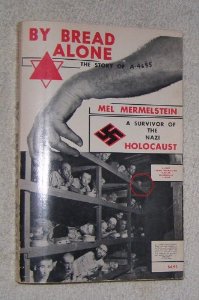
First edition of Mermelstein’s book came out in 1979.
According to our esteemed correspondent Attila Kovacs, his reading of Mel Mermelstein’s survivor story reveals no mention of the famous Elie Wiesel, even though the book first came out in 1979 when Wiesel and his own story was already well-known among the general public.
The first edition [right] was 264 pages, published by Crescent Books. In 1981, a second edition of the book [below right] came out, following Mermelstein’s dispute in 1980 with the Institute for Historical Review (IHR) over his claimed proof that even a single Jew was gassed at Auschwitz.
The second edition of By Bread Alone was published by the “Auschwitz Study Foundation” and retains the same cover design, but with some new text added referring to the author’s successful lawsuit. It is expanded to 290 pages from 264 pages in the first edition – an increase of 26 pages to include the lawsuit story. The new cover texts reads:
who, in 1981, filed a lawsuit for 17 million and 50 thousand dollars against the Institute for Historical Review, a Torrance, California-based organization of revisionists and pseudohistorians who claim the Nazi Holocaust is nothing but a hoax, a Zionist plot.
The only other change is that the price that was printed in red on the lower tab on the right side has been removed.
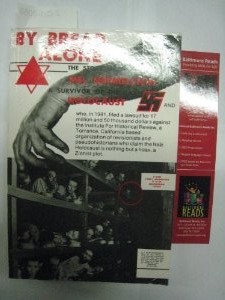
2nd edition of book came out in 1982.
How well-known was Elie Wiesel in 1979?
It was 1978 when Wiesel was appointed by President Jimmy Carter as chairman for the Presidential Commission on the Holocaust (later renamed US Holocaust Memorial Council), indicating that he was at that time a recognized ‘authority’ on all things ‘holocaust.’ In fact, Wiesel claims that it was he who coined the term ‘Holocaust’ for the Jewish ‘Shoah,’ even though he doesn’t like the term. Typical Wieselspeak. That’s a term I just coined!
In 1979, Wiesel’s 15th book was published, the title being A Jew Today, a collection of essays, letters and diary entries weaving together all the periods of his life up until then. To put out a book such as that, one has to have a substantial following. Fifteen books by 1979! It is unimaginable that a Hungarian ‘survivor’ such as Mel Mermelstein would not be familiar with Elie Wiesel.
Attila Kovacs tells us what he discovered reading Mel’s book
In his own words he writes:
First, I must admit that reading the book the second time was somewhat of a struggle as there were so many confusing items, too many irrelevant, random photos, and the quality of the story left a lot to be desired from a strictly literary sense. The author jumps around as to his own identity as a Jew, (he is) a Hungarian Jew, a Czechoslovak, a Karpatho-Rus, and a Czech – to the point that I was confused as to what his main claim was as to nationality, mother tongue, ethnic origin.
But as to his being Hungarian, there is little doubt:
Lajos, his brother, Magda, his sister, and friends Joncsi (probably just a typo as Jancsi is a common Hungarian name), Pista, and Moric are all Hungarian names; in this regard, Etu may be Eti. His labor camp documents all say Ungarn, which is Hungarian in German. In addition, he refers to his hometown as Munkacs, which is Hungarian. It is telling in that the author did not use the Czech or Slovak spelling of Mukacevo or Mukaceve or the Ukrainian/Russian name of Mukacheve. Then on p. 17, he calls out to his father as ‘apu’ which is Hungarian for father.
As such, one has to assume that his mother tongue used in the home and in Munkacs and in the camps with other Hungarian Jews is Hungarian. In “Youtube” videos showing life in Munkacs in the 1930′s – the Jewish schoolchildren singing, a large town center wedding, and street conversations of the Jews are practically all in Hungarian.
Since in Elie Wiesel’s own “Youtube” video of his return visit to his hometown of Sighet he is speaking Hungarian with the old town folk, it seems that Moric (Mel) and Elie would have a lot in common and would converse in Hungarian at Buchenwald.
Yes, you would certainly think so. But one can get the impression that Wiesel is unable to converse comfortably in Hungarian because he often refuses to speak it in public. As he did with Nikolas Grüner in Stockholm. However, you would know this better than I.
The only reference in the book to Elie Wiesel is on page x, prior to the Forward, where it [quotes] a statement made by Professor Elie Wiesel of Boston University. So apparently the author knew of Professor Wiesel at the time he wrote the book.
There is a mention on p. 195 of “walked from one barracks (at Buchenwald) to another until I found Elijah, a frail bent youngster from Sighet.” There were a couple of other name mentions of Elijah, but nothing other than the name. So if this was indeed Elie Wiesel, one would think that the author would brag about this important Holocaust celebrity or their common roots, or their common experiences in the Munkacs-Sighet Jewish community, or about what they did together in Buchenwald especially with respect to the famous Buchenwald Liberation photo.
Yes, indeed. “Elijah” cannot be Elie Wiesel. For one thing, Wiesel was not frail and bent. The man he purports to be himself in the Famous Buchenwald Lie-beration Photo on Mel’s book cover is not frail looking at all. (Of course, I should hardly mention that since it’s been proven not to be Elie Wiesel.) But also, photos of Elie Wiesel in France from July-Sept. 1945 onward show a sturdy, vigorous, smiling lad with a head full of longish black hair. Plus Elijah was not an uncommon name amongst the Orthodox Hasidic sect of Hungarian Jews, and some from this sect were in the camp.
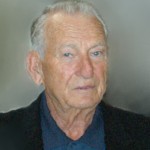 Does Mermelstein give many dates in his book? According to this source, he arrived at Buchenwald on or about February 10, 1945, he remained in the camp until it was liberated by American troops on April 11, 1945. That is only a 2-month stay. He was born on Sept. 25, 1926, making him exactly 2-years older than Elie Wiesel. He is now around 85. (recent photo of Mermelstein at left)
Does Mermelstein give many dates in his book? According to this source, he arrived at Buchenwald on or about February 10, 1945, he remained in the camp until it was liberated by American troops on April 11, 1945. That is only a 2-month stay. He was born on Sept. 25, 1926, making him exactly 2-years older than Elie Wiesel. He is now around 85. (recent photo of Mermelstein at left)
The same source also states this important information: In none of the numerous newspaper interviews he gave prior to 1980 (that we were able to discover) did he make any mention of seeing anyone go into any gas chamber [at Auschwitz-Birkenau]. Similarly, Mermelstein makes no mention of seeing his mother and sisters enter any building or “gas chamber” in the first, 1979 edition of his detailed memoir, By Bread Alone (written before the reward offer).
By the way, the liberation photo is only mentioned on p. 223. Less than one solitary page devoted to the cover picture which shows the author in the upper, most distant spot in the photo. Oh, well.
This confirms my theory in the previous article that 1) it did not mean as much to be in this picture prior to the identification of Elie Wiesel in it, and 2) Wiesel was not identified in it until 1983, after both editions of Mermelstein’s book had been issued. Even though Mel used the picture on the cover of both editions (without the standing man), it was probably only to prove that he was there and that it was as bad as he said it was. That the photo without the standing man was used on both editions also proves that it was not a mistake or an oversight; if it were it would have been corrected on the 2nd edition (unless, of course, this was a real low-budget operation and making a change on the cover was cost-prohibitive).
A can of worms has been opened here, there is no doubt about it.
What is most interesting is the disclaimer on page iv of the book, which I quote: “About the Characters in This Book – Though the characters in this story are real, I felt their names had to be changed to protect their privacy. I have not consulted with any of the survivors mentioned here, because I know how some might feel if the story of their part in the Holocaust were brought to them once again to be dealt with.”
Wow! Go figure then: why he would use his own name rather than a fictitious name; not want to fact check with known survivors; be concerned about privacy when others had written their own books (cannot recall how many in the photo have written their own books about Buchenwald and/or Auschwitz, etc.)
I don’t know of any book by anyone who was actually there; a lot of fraud is involved with this photo. But nevertheless, he certainly would not have changed the name of Elie Wiesel, since this man had already made his own experiences at Auschwitz and Buchenwald very well known. Mel could not speak of Elie Wiesel in Buchenwald because he never met or saw such a person there! Just like Nikolas (Myklos, Michael) Grüner, Mel Mermelstein was actually in Buchenwald (although he lies about what happened to his family and others) and thus his silence on Elie Wiesel completely refutes the testimony of Wiesel.
Nikolas Grüner and Morik Mermelstein are in the Buchenwald Lie-beration photo, but the fraud known as Elie Wiesel is not.
The author, Mr. Moric Mermelstein, does NOT mention or say anything about who (names or descriptions) was with him in the photo of barracks 56 on April 16th around noon.
Query: Whether or not an author in an iconic photo of yesteryear would not mention that in the old grainy middle school team photo the fact that Michael Jordan was in fact the scrawny, short but smiling kid at the end of row two sandwiched between the team water boy and a forgotten assistant coach?
Yes, Attila is so right. If such an “iconic” person were with you during a period of your life that you are writing about, and even in the same room — and a photograph existed that showed it — well, anyone would certainly mention it. There can be no doubt that Mr. Mermelstein’s book has given us more proof that Elie Wiesel is not in the Buchenwald picture. I don’t suppose Mel will be too pleased with helping our revisionist cause, but so he has. Thanks Mel! You won a battle, but you’re losing the war.
Wednesday, February 13th, 2013
by Carolyn Yeager
The interview with psychiatrist Max Hamburger that appeared in the March 2012 Dutch magazine Aanspraak was translated into English for me by Hasso Castrup. Some things that Hamburger said are revealing of his overall honesty when it comes to his statements about “the Holocaust.” Being a “holocaust survivor” who appears in the famous photograph is, after all, his only claim to fame.
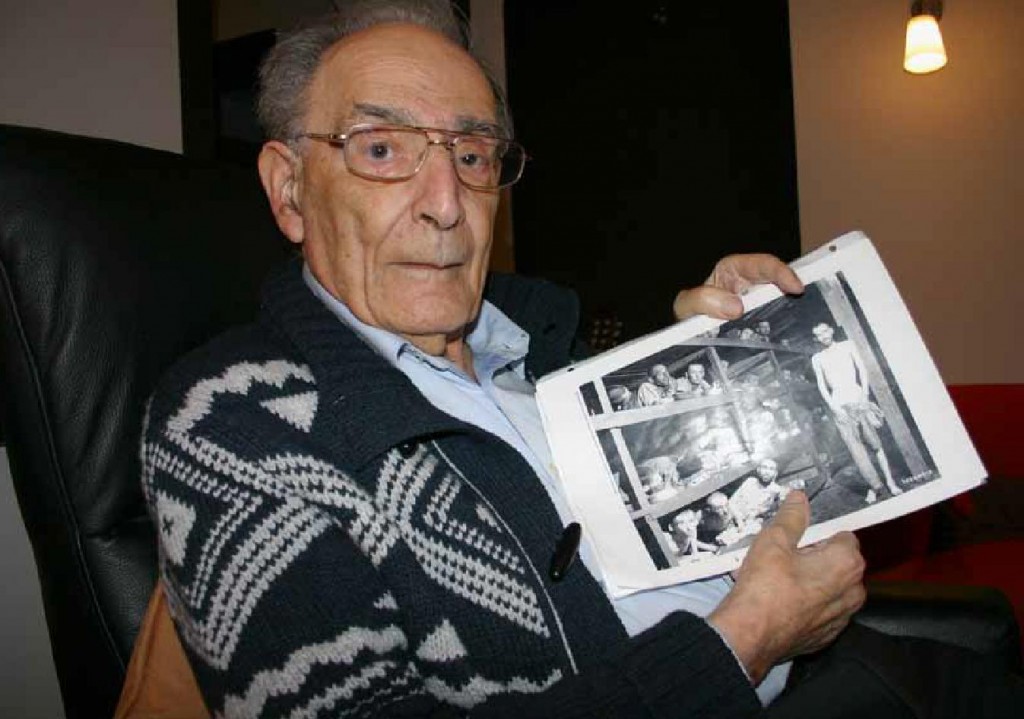 Max Hamburger in 2012 pointing to himself in the Famous Buchenwald Lie-beration Photo from 1945 (Source: Aanspraak magazine)
Max Hamburger in 2012 pointing to himself in the Famous Buchenwald Lie-beration Photo from 1945 (Source: Aanspraak magazine)
I’ve already reported in a previous article (scroll down to end) that his father was an Amsterdam diamond merchant, Hartog Hamburger, who died from a bizarre accident when Max was only four years old. His mother, a fashion designer, worked even harder after that and often left him with his grandparents. When Max was ten, his brother died of leukemia, leaving Max alone with his mother. This is quite a lot of trauma in the first ten years of life, which couldn’t help but leave a mark on his psyche.
He says his brother’s death is what inspired him to study medicine, beginning in 1938 when he was 18. But in 1942, further public education was denied to him because he was Jewish. His job with the Jewish Council (Judenrat) allowed him to remain immune to deportation to Westerbork by getting a special stamp on his Ausweis (ID). In the summer of 1942, he went to work as an intern at the New Israelite Hospital, where he learned that when the substance ‘Pyrifer’ is injected intravenously it will cause high fever similar to what one gets with malaria or typhoid. Hamburger began injecting this into the Jewish patients so they would be declared unfit for deportation.
This, of course, raised suspicion among the Germans and Hamburger says in June 1943 the New Israelite Hospital was raided, in order to be emptied. He and other medical personnel hid patients under laundry and in the morgue, and led seriously ill patients into hiding (?). He is proud to describe himself as part of the Resistance and says he was later awarded with a memorial cross because of it. He tells a story that describes how in August 1943 he once again escapes deportation, but I’m not repeating it because there is no way to assure it’s true.
Working with the Resistance
He then moved to the Jewish Handicapped (Asylum) at Weesperplein, where he and other doctors again tried to”save” as many patients as possible by declaring them ill with contagious diseases. He says at the Portuguese-Israelite Hospital people in mixed marriages were to be sterilized. Along with most of the staff, he refused to cooperate and went through a hidden door into a neighboring villa and went into hiding. He and his girlfriend were married by a rabbi; they were both fully into the Resistance now. His mother was also brought to where he was, but she quickly hid herself elsewhere.
He says that “shortly afterwards we were betrayed and arrested, interrogated and deported to Westerbork. My mother was also betrayed.” On Sunday, February 6, 1944, he saw her for the last time in the penal barracks at Westerbork. They fell into each other’s arms and cried. But then … “In Auschwitz I met a fellow radiologist who was deported together with her. He told me that my mother was gassed on March 6, 1944. I arrived there on February 10, 1944 (his 24th birthday, but he doesn’t mention it), but did not see her again.”
Since we know there were no gassings at Auschwitz – this is a dead giveaway that he’s telling a big lie, although he’s putting the lie in the mouth of an unnamed “fellow radiologist.” This is a trick that is used often by so-called witnesses and “survivors.” The so-called informant should always be named; if they can’t name the exact source of the information, they should not be believed.
At Auschwitz, he at first failed, then succeeded in becoming recognized as a doctor. He began on a work detail where he says he was “poorly dressed in the icy cold damp weather, the work meant a maximum survival of 3 months.” (We hear so often that the life expectancy was “3 months,” but why did most inmates not only live until liberation, but into old age after it? Hamburger himself is 93 years old – Feb.10, three days ago, was his birthday.) As a doctor, he supervised the cleaning of the barracks during the day, in the afternoon handed out soup, evenings he did lice control. What’s so hard about that? Yet he says that in April he developed a fever, and on May 1st managed to avoid the medical inspection (a strange story of ‘luck’) in order to be included in a transport of Hungarian “forced” laborers headed to Silesia. He says this “saved his life” (considering his 3 months were almost up, don’t you know).
According to this, Hamburger was at Auschwitz from Feb. 10 to May 1, 1944 – a little less than three months. This was the usual length of quarantine at Birkenau for those who were then sent to other camps as labor. During the 2 to 3-month quarantine period the inmates did not work, so I do think his account has quite a bit of invention in it so as to not sound like quarantine. His mother would also have been in quarantine and he would not have seen her there, being the men and women were strictly segregated into separate camps. This is the usual situation from which “survivors” claim their relatives were gassed, the information so often coming from a nameless fellow inmate; sometimes from a “sadistic guard.”
After Auschwitz, the story gets more confusing
The train took them to Gross Rosen, where an old factory was assigned as their hospital. He says “we” had to vaccinate everyone against typhus in February 1945. Their only hope were reports of advancing Russians and Americans, which they knew of because a fellow prisoner secretly listened to the radio. At the evacuation of the camp they had to walk in the snow to the Czech Republic. From there they were taken by train from Prague to Flossenbürg camp in Bavaria.
According to USHMM, Gross Rosen camp was evacuated in early February ’45 and “about 40,000” from the main camp and sub-camps had to march west. This is a lot of inoculation to be done in a few days. But more important, the 9-month period he spent at Gross Rosen between May 1944 and February 1945 is blank. May 1944 coincides with the time of the large Hungarian deportation to Auschwitz; Hamburger says he was with a Hungarian labor unit that had already been to Auschwitz and sent out from there. Would not the new arrivals also have been sent out from there in like manner? From here on, his narrative remains very sketchy, and is mostly made up of vague horror stories.
He says, “The camp guards were shooting prisoners who were their live targets in the white landscape. Daily there were death sentences and prisoners were hanged before our eyes.” Yet the prisoners were needed to work in the quarries and Messerschmitt factories … and they had been innoculated in February against typhus, no doubt at some expense. So why would they be wasted as target practice for the guards? This is when survivor stories become really unbelievable. At the beginning of March 1945, he says they were deported to Ohrdruf, a work camp of Buchenwald. “Here were bombproof underground factories for assembly of V-weapons. After underground explosions with dynamite, we were to remove the big stones from the corridors by small-gauge trains.” But he doesn’t stay there. “We had to walk for four days and nights 80 km (approx. 40 miles) through the snow to Buchenwald.” Although he says he was practically “in a coma,” he’s clear about the dates and distances.
“On 11 April 1945, Buchenwald was liberated by the American army. Five days after the liberation our well-known picture (was taken). I lie down there, fourth from the left. As I lay there someone advised me to go to the hospital, because I otherwise would not survive. “If they do not record you, you go ‘under the grass.’ When an American goes by and sees you lying, he makes sure that you get recorded. And so I went. With DDT powder I was lice free. The lice and I got U.S. baby food! For me THAT was liberation. During a night in the hospital, I knew: ‘If I fall asleep, I’ll never wake up and I won’t be able to testify to what happened to us.’ I fought that night to the utmost against sleep and thereby I survived.”
From the beginning of March to April 11, Hamburger has nothing to say except that he spent 4 days walking from Ordruf to Buchenwald and that he was in the photograph taken on April 16. He doesn’t give the date that he arrived at Buchenwald. What he tells can be picked up from any number of accounts of the time period. Can we believe he was even at Buchenwald? Why was he in that barracks #56? How long was he there? Why did “someone” have to tell him to go to the hospital 5 days after the Americans arrived? All very implausible since he was a medical professional.
But beyond all this is the fact that the figure he says is him is indeed a retouched copy of the figure in the row above, 3rd from the left. He doesn’t claim any relationship to that person, who has been identified (inaccurately) by Yad Vashem Museum as Yehuda Doron or Yaakov Marton. This famous photograph has been proved to be a composite photo created by a U.S. military intelligence department to be used in the ongoing propaganda war against Germany and Hitler’s Third Reich, so everything about it is suspect.
The rest of what Hamburger said in the interview does not apply to the questions I have. Again, my primary question is: When did Max Hamburger first say he was in that photograph? Like so many others, it was not at liberation, nor in the years following. In fact, there is no information that I have found as to when this did occur. Why? Because it must be recent – too recent.
Concluding thoughts
In 1945, Max was 25. He wrote that he and the loyal wife he married when he was 22 were divorced sometime around or after 1957, and he is now with his third wife.
“For a long time I have been a psychiatrist and I have helped many war victims thanks to my own experiences. Until I could no longer afford to listen to them. Unfortunately I never found a psychiatrist who could help me. I regret that I was a bad partner in the previous marriages, but that’s because I was in the grip of the past I had lived through. I find it annoying when people make demands on me and I can get angry.”
I bet he could sure get angry with me! I am making demands on Max Hamburger to fill in the blanks in his “holocaust survivor” story. I don’t have any reason to doubt the early part of his story but, starting with his and his mother’s arrival at Auschwitz, there is much to question.
He is, from all appearances, a loyal Jew with the typical Jewish desire to avenge the “wrong” done to his people and the interruption and pain in his own personal life. Telling lies to accomplish this is not, therefore, a wrong in his eyes. A wrong for a wrong is, for Jews, a fair exchange … nothing to be ashamed of. This may even be how he counseled his patients.
2 Comments
Category Featured | Tags: Tags: Auschwitz, Buchenwald, Dutch Resistance, Gross Rosen camps, holocaust survivor, Max Hamburger, photo forgery, Westerbork,
Social Networks: Facebook, Twitter, Google Bookmarks, del.icio.us, StumbleUpon, Digg, Reddit, Posterous.
Wednesday, February 6th, 2013
By Carolyn Yeager
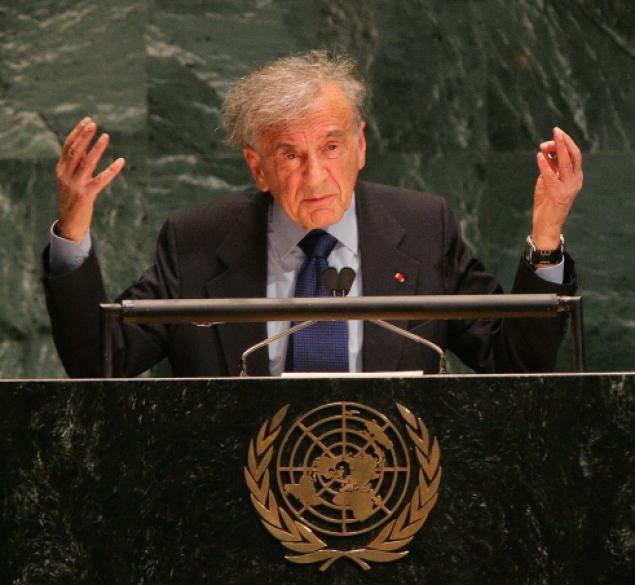 Elie Wiesel at the United Nations in January 2005. This is the photo accompanying his gun control comments in the New York Daily News. If he looked this bad then, what does he look like now, 8 years later. Is that why we don’t see him any more?
Elie Wiesel at the United Nations in January 2005. This is the photo accompanying his gun control comments in the New York Daily News. If he looked this bad then, what does he look like now, 8 years later. Is that why we don’t see him any more?
If Massacre of 20 children in Newtown doesn’t bring gun control, what will? by Elie Wiesel
So reads the headline in the New York Daily News on Dec. 17, 2012 – just three days after the Sandy Hook, CT, shooting event. Okay, I’m pretty late in commenting on this Elie Wiesel story but I just now happened upon it. The Daily News is as Jewish as it gets for a “mainstream” paper and we know (or can see) that removing American’s constitutional gun rights is part of the Jewish agenda that it is promoting.
We can see that the Jewish Mafia that runs this country put their big gun Elie Wiesel on it from the get-go. Even though Wiesel’s byline is attached to this story (he’s a journalist, remember), I suspect the words have been partially scripted for him and he just adds his own flavor and style to them. The news story reads (my comments in blue):
Disbelief, horror, revolt: This is what we all felt when the news arrived. By its magnitude and cruelty, it surpassed everything else. We were not ready for it. Earlier tragedies should have immunized us. But they didn’t. Not to this violence, to this bloodshed. Oy vey, The Children!
A young man assassinates his mother with her own weapons. Then, he goes to an elementary school and murders 20 children, one after the other, firing more and more bullets into their small bodies. Just three days after the event, he is sure of this. The story was prepared ahead of time, and was given out almost one hour after the deed supposedly occurred. Wiesel, of course, doesn’t question any of it.
Why?
The need, the desire to understand is as strong as the pain itself. Wiesel’s trademark is ‘trying to comprehend the evil.’
Propaganda inserted here:
Today, the Daily News is launching a petition to call for the ban of assault weapons. To participate, print and send in the form at the bottom of this page, or SIGN ONLINE HERE.
Somehow, in spite of the lost lives that we read about in street fights, in poverty-stricken neighborhoods, in faraway war regions such as Syria and Afghanistan, we were unprepared to see this kind of evil in action. Since there is obvious evil everywhere by highly armed men, especially in Gaza, ,Elie has to help us to see that THIS is an even worse evil. It’s always about evil, and Elie is the one we can depend on to point it out to us.
EDITORIAL: THE NRA’S COMEUPPANCE
HAMMOND: HOW NEW YORK CAN LEAD THE WAY … more propaganda
What does it say about the world, the culture we live in, the ideas we cherish and the education we receive? Yes, what? He always asks the question; never gives the answer.
In the most passionate address of his life, President Obama spoke for all of us when he said that his heart was broken. So was ours. Oy vey. Other areas of our being were also affected. If the death of one child is a tragedy, the murder of 20 is a scandal of outrageous proportions. Oy vey!
Beliefs and certainties are to be reexamined, habits and values reevaluated. In the face of so much pain and mourning, we must not ignore the question: Where did society go wrong? What made humanity so frail, so blind? Where did education fail? What does such an outburst of anger say about our generation’s hopes and ideals? Oy vey! But where are the answers?
In other words: Is there anything we can learn from this event? That all murder is evil but that of children is seven times seven more? That the ease of acquiring a weapon is no longer acceptable. If this tragedy does not produce universal gun control, what can and what will? What else do we need for preventing further horrors such as this? Oy vey. Finally an answer: We should no longer be able to acquire weapons. That will do it.
And what do we know about the perpetrator? We know he didn’t finish college and struggled socially. But what did he do in his spare time? What books did he read? What music did he listen to? What was he dreaming about? What made him laugh or weep? Double Oy vey.
We must discover, to the extent possible, what his secret ambitions were. Why? We must remember: He was not a stranger from another planet.
He was one of us. Oy Vey!! Was he Jewish?
Wednesday, February 6th, 2013
By Carolyn Yeager
copyright 2013 carolyn yeager
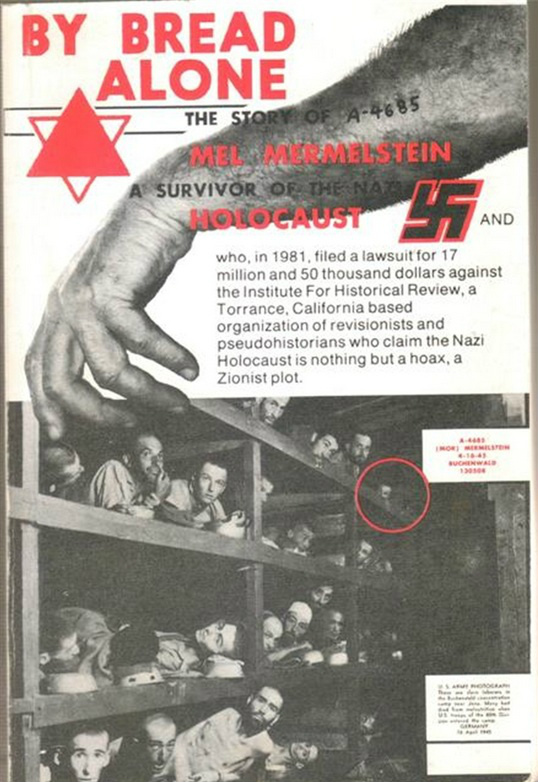 Once again, a helpful commenter on this website has brought us an important discovery. Thanks to Attila Kovacs, I looked up Mel Mermelstein‘s 1979 “survivor memoir” titled By Bread Alone: The Story of A-4685 and discovered just what Kovacs reported — that the Famous Buchenwald Liberation Photo that is on the cover of the book (with Mel’s face circled in red) does not contain the tall standing man. In Kovacs’ words: “What is not shown on the cover photo is the tall man standing on the right leaning on the post. The post is there, but why then not the man standing?” Good question.
Once again, a helpful commenter on this website has brought us an important discovery. Thanks to Attila Kovacs, I looked up Mel Mermelstein‘s 1979 “survivor memoir” titled By Bread Alone: The Story of A-4685 and discovered just what Kovacs reported — that the Famous Buchenwald Liberation Photo that is on the cover of the book (with Mel’s face circled in red) does not contain the tall standing man. In Kovacs’ words: “What is not shown on the cover photo is the tall man standing on the right leaning on the post. The post is there, but why then not the man standing?” Good question.
Another helpful reader supplied the larger image of the book cover, from Google Images! I confess, I never thought to look there. Thanks Simon! Now you can even more clearly see the post on the right edge of the picture, with no one standing beside it – just dark, empty space.
Kovacs continues, “On page 208 of the book, the same photo is reproduced, but magically the tall standing man is included in this photo. What the heck is going on?”
What seems to be going on can be explained this way: Elie Wiesel was not identified in that photograph until the 1980’s. As I have written elsewhere, it was a decision made to increase Wiesel’s chances for a Nobel Prize. He wanted one, and his supporters began in 1983 to lobby the Nobel committee and plant news stories that he was being considered for either the Peace Prize or the Literature Prize. In 1986, the Peace Prize was awarded to him. The first thing he did as follow-up was to travel to Yad Vashem holocaust memorial in Israel to express his appreciation and get photographed in front of a wall-size blow-up of that famous picture.
Why are these dates important?
Mermelstein’s book came out in 1979; Elie Wiesel was first identified in the photo around 1983, so Mel would not have been aware that one of the men laying just two rows below him was (supposed to be) Elie Wiesel. He would also not remember a man standing naked when the photograph was taken … since there wasn’t one. When he saw this picture for the cover, it would have looked right to him. An editor may have added the pictures inside the book, without realizing the discrepancy with the one on the cover. We have already seen evidence of how most people miss sensing anything wrong when viewing the picture without the standing man.
An alternative explanation could be that the standing man was too dominating in the picture, taking visual attention away from Mel the author, who was way back in the upper bunk, barely visible. If this were true, however, it would verify that there are indeed two versions of the picture known — one with and one without the “naked” man. But also, since it has already been proven that this standing man was added by “photo composite” techniques known at the time, we know that he was not in the original photograph taken on that day.
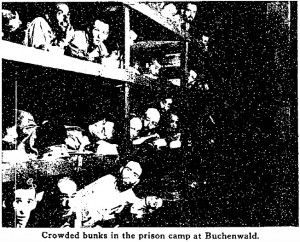 This image (left) from a story in the New York Times, May 6, 1945 is exactly the same as what is on Mermelstein’s book cover. We can see the post, everything is there except the standing man next to the post. The man has not been ‘removed’ – he was never there. Those who want to argue that he was removed should provide an explanation of why and how that was done if they want us to believe it.
This image (left) from a story in the New York Times, May 6, 1945 is exactly the same as what is on Mermelstein’s book cover. We can see the post, everything is there except the standing man next to the post. The man has not been ‘removed’ – he was never there. Those who want to argue that he was removed should provide an explanation of why and how that was done if they want us to believe it.
Does Mermelstein write in his book about meeting Elie Wiesel at Buchenwald?
I can’t find a readable version of the book online, but since Attila Kovacs has a copy we can ask him: What does Mermelstein say about Elie Wiesel being in the famous photo with him? If he says nothing, that is further proof of Wiesel’s chicanery. In looking at reviews of this book, I don’t see Elie Wiesel’s name anywhere. I am under the impression that the book is more about Mel’s lawsuit against the Institute for Historical Review than about his experience in the camps. So we’ll leave it here for now and see what more Attila Kovacs can tell us.
UPDATE: Feb. 10
For those who want to see a better quality image, this was taken from Winston Smith Ministry of Truth website. He obtained an original NYTimes Magazine from May 6, 1945. However, the man 2nd from the right in the upper row (to the left of Mermelstein) is not the same face or person as the standing man, as some want to believe.
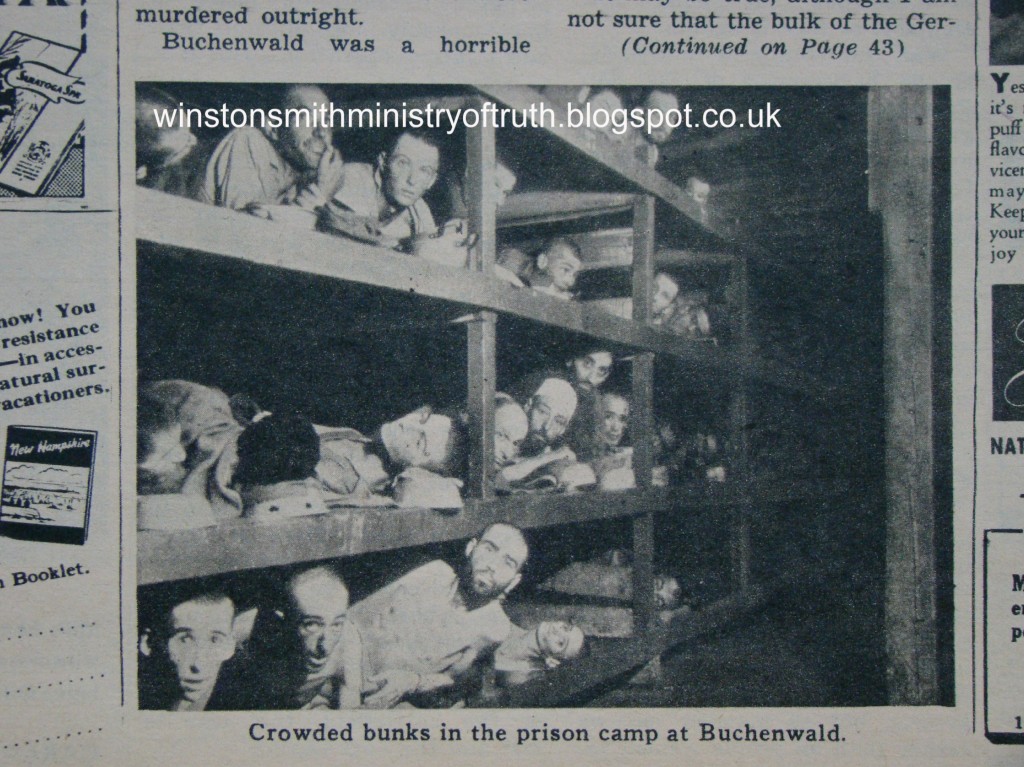
Tuesday, January 8th, 2013
By Carolyn Yeager
The man who now calls himself Naftali Prince (Fürst translates to Prince in English), and who was also known in childhood as Duro Forst, is the person circled in both photos below, taken at around the same time shortly after the Buchenwald “liberation” on April 11, 1945.
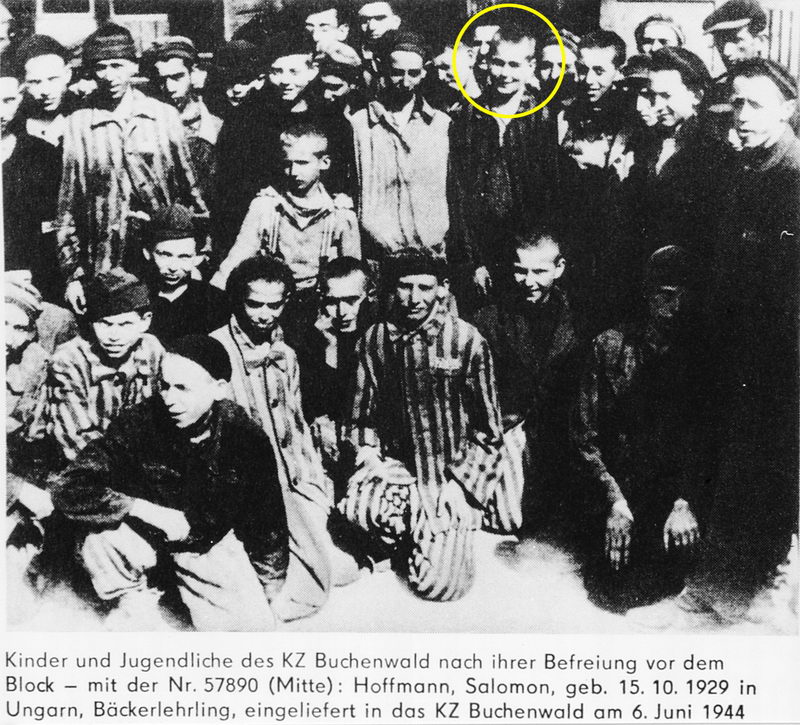 Above: “Buchenwald children on the release day. Naftali Fürst is marked in a yellow circle.” (As per Naftali’s website, http://furststory.com/English/Holocaust_Kinder.html)
Above: “Buchenwald children on the release day. Naftali Fürst is marked in a yellow circle.” (As per Naftali’s website, http://furststory.com/English/Holocaust_Kinder.html)
Below: “Buchenwald. Naftali Furst is marked with a yellow circle.” Can this be a 12-year-old boy? The man two rows directly below him is identified as being 25-yrs old.
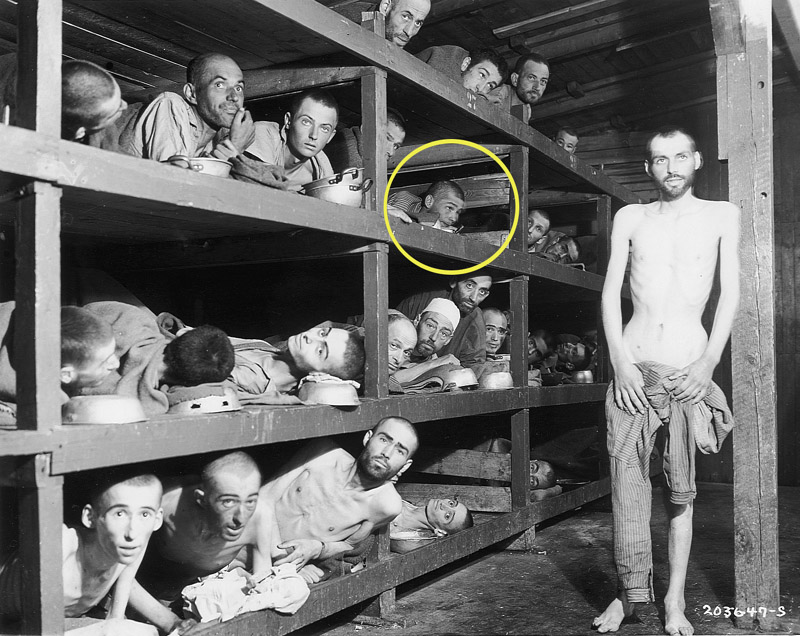
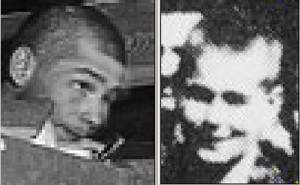
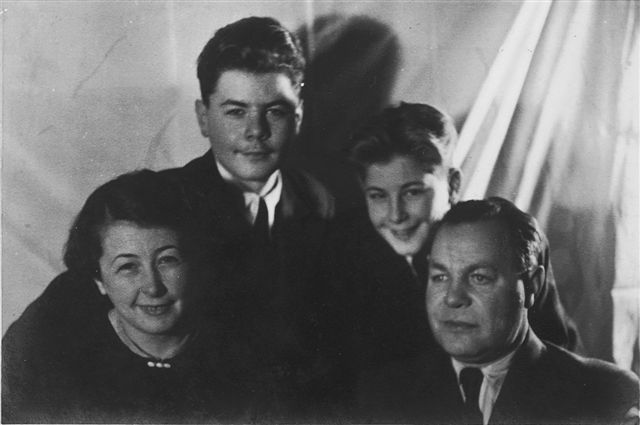
Below left: “Our parents and us after the war” (As per http://furststory.com/English/YaldutMomDad.html) Naftali is to the left of his father, although he strongly resembles his mother, while his older brother takes after their father.
Why is it that he looks younger in the family photo, at age 13 or 14, than he does a year or two earlier in the barracks? Because it’s not him in the barracks, that’s why. Simply look at the difference in the forehead in the comparison of the two faces. The man in the bunk has a low hairline (short forehead). The real Naftali Fürst has a higher forehead. Thus he’s another one who succumbed to the temptation to join an exclusive club by falsely identifying himself in this famous photo. The holocaust museum people will never investigate and will never say otherwise.
Other evidence that refutes Fürst-Prince being in the photo
Naftali and his brother Shmuel (also known as Ďuro and Peter – their Slovak names) wrote a family recollection and published it sometime around 1998. In it, neither mentioned that Naftali was in the famous Buchenwald liberation photo. Naftali wrote in the Preface:
For over fifty years, my memories and emotions have been repressed deep in my soul.
He was born in 1933; the brothers were five and seven in the fall of 1938. At the end of 1942 they moved into the Sered detention camp (photo below).
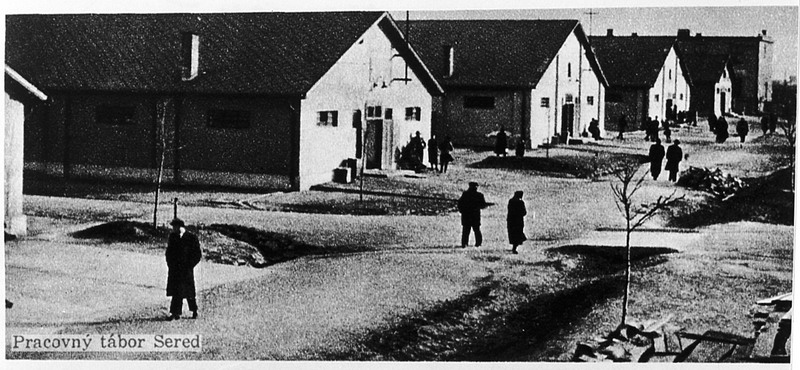 Of this, Naftali wrote that it
Of this, Naftali wrote that it
… was the most acute transition in the life of our family. We left behind a big house with a housemaid and nannies and a car, and moved into a tiny room.
Until the end of 1943, life in the camp went on in a relative stability. Until August 1944, the output of products manufactured in the camp contributed largely to the economy of Slovakia …
Beyond work, cultural events such as poetry readings, as well as soccer matches, were part of the agenda. Inside the camp, there was a small swimming pool. Every now and then we were permitted to go for a swim. Among young men and women, love affairs were flourishing.
The nearby hospital was an important institution. Prior to the war, there was a Jewish hospital in Bratislava. Its entire medical facilities were transferred to Sered. During our stay in the camp, Shmuel had an urgent appendicitis surgery in that hospital. Its proximity to the camp saved his life. By February 1944, Shmuel was thirteen years old. With great efforts and despite all obstacles, our parents managed to celebrate his Bar-Mitzvah.
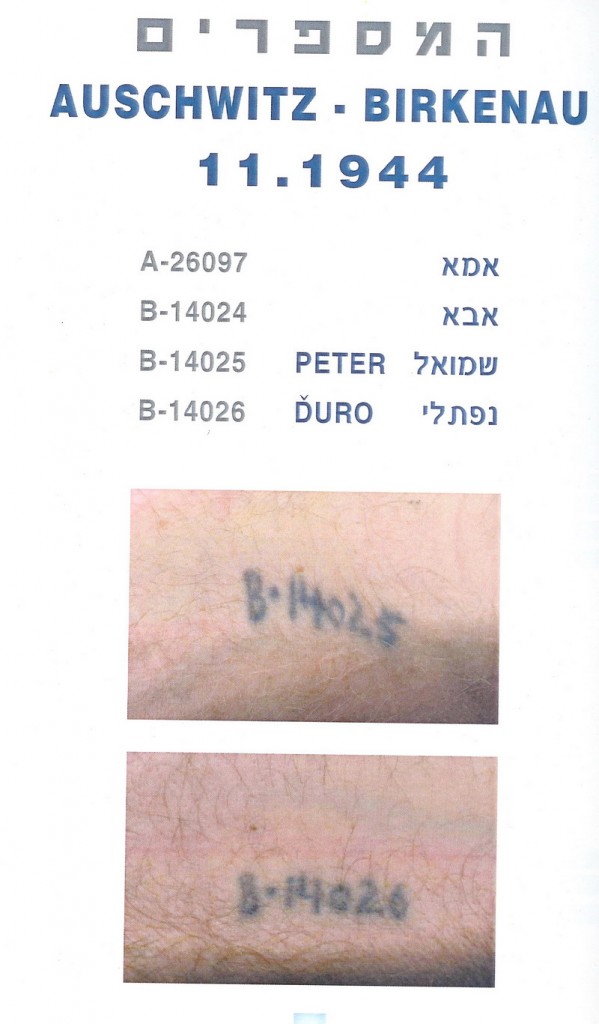 On November 2, 1944 the family was put on a train to Auschwitz-Birkenau. According to the story, the men got the following tattoos:
On November 2, 1944 the family was put on a train to Auschwitz-Birkenau. According to the story, the men got the following tattoos:
Dad’s number was 14024, Shmuel’s 14025, and mine 14026.
(The chart at right was created in Israel and may be truthful or may not; it is included in the family history.)
Move to the Kinderblock
After a short period, we were ordered to join with other children and youth, and move to the “Kinderblock”, the Children’s Block.
Naftali was just going on 12 years old and Shmuel was going on 14. In December they were moved to an agricultural farm near Auschwitz, at which there was little work for them to do.
On January 19, 1945 we were ordered to get ready for leaving the camp and a long march away. […] On the following morning, part of the farm equipment was loaded on horse-drawn wagons and the march begun: the wagons rolled in the front, while we marched behind them.
Naftali writes the march took 3 days and nights before they reached Breslau, followed by a day and a half train ride to Buchenwald. (This is considerably longer than the one-day march from Buna-Birkenau to Gleiwitz and train to Buchenwald that others described.) The brothers were eventually together in the children’s barracks, Block 66. After being there awhile, Naftali developed pneumonia and was transferred to a hospital. After recovering some, he says he was moved to a room in the Brothel where he enjoyed relative luxury. Then:
In the morning hours of April 11, 1945 we began hearing sound of artillery. While the frontline drew nearer and nearer, the underground rose up. On that very day Buchenwald was liberated. And where was I liberated? In the Buchenwald whorehouse! Not every twelve-year old child had such a privilege…
During the first days of freedom, there was a lot of disorder. As we were not allowed to leave the camp, we strolled aimlessly from one barrack to another. Then we went to see the crematorium and the torture cells, and finally we opened the clothes warehouse. There we wore SS uniforms.
It did not take long until we were organized into groups according to our countries of origin. Among the organizers was a man who pretended to be the brother of General Viest, a Slovak hero. He took care of the Czechoslovak group, Which a fortnight later was taken by trucks into Czechoslovakia. Upon our arrival in Bratislava, we were welcomed by the Jewish community, Which was already functioning.
Nothing is said about being photographed in Block 56 and having his image immediately displayed all around the world.
When did Naftali Fürst first decide he was in that photograph?
I would say it would have to be after 1998, after publishing the family story he wrote with his brother that is titled “Fürst Brothers.” Did someone suggest it to him or did his photographer’s eye detect an opportunity? As with all the others, the claim of being in this photo came many years later, not until the 1980’s or 90’s, and even into the 2000’s. There is a reason for this. Where are the pictures of them from that time? And where are the records? No one in that photograph was named at the time, so it is a free-for-all now to to claim yourself to be one of those faces.
After the war, Naftali studied photography in Bratislava and names his profession as Photographer. In 1949 he moved to Israel, where he still resides.
A passion for Remembrance and Revenge
“The 12-year-old boy in the 3rd row of the wooden bunks – that’s me,” says Naftali Fürst to anyone who will listen. In his hand he holds a famous photo that he almost always carries with him, because it has become part of his memory. “Inclusion in Buchenwald was the so-called death row,” recalls Prince. “I was so sick, almost on the other side.”
During the 7th Yad Vashem seminar of Remembrance in March 2004, Naftali Fürst told parts of his life story to a group of Austrian teachers. For nearly an hour he revealed fragments of his memories.
In the Preface to his family story, Fürst revealed his feelings that remain with him today:
Germans – I loathe the Germans of that era, particularly those who wore SS and Gestapo uniforms. Therefore, I decided to mention them only where it was absolutely necessary.
Max Hamburger and Nicholas Grüner (see previous posts on this blog), for no doubt similar reasons, are also anxious to speak about and embellish their long-ago ordeal anywhere they are invited. They receive great sympathy and have even become somewhat famous simply for being in the “famous photograph.”
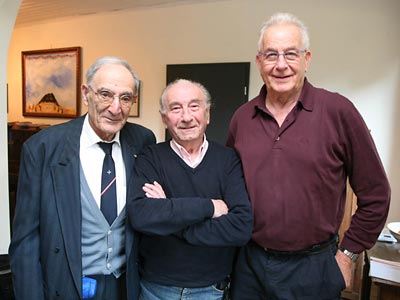 “They didn’t know each other” at Buchenwald
“They didn’t know each other” at Buchenwald
Even though they all say they are in that picture taken on April 16, 1945, and Grüner and Fürst both say they stayed in the children’s Block #66, they did not know each other. The three men met for the first time when the now deceased journalist Ursula Junk brought them together on the 60th Anniversary of the liberation of Buchenwald in 2005.
On the occasion of the commemoration of Kristallnacht on November 9, 2006, they met again in Germany at the home of the artist Christiane Rohleder, in Much near Bonn. Invited by the Archivist of the Rhein-Sieg-Kries, Dr. Claudia Arndt, they each told the story of the 1945 photograph to the students — three painful biographies. If you believe it.
Brothers in spirit: Max Hamburger (from left), Nicholas Gruner and Naftali Fürst. Photo: Axel Vogel
4 Comments
Category Featured | Tags: Tags: Auschwitz-Birdenau Kinderblock, Breslau, brothel, Buchenwald Block 66, Buchenwald Lie-beration photo, Max Hamburger, Naftali Fürst, Naftali Prince, Nicholas Gruner, Sered detention camp,
Social Networks: Facebook, Twitter, Google Bookmarks, del.icio.us, StumbleUpon, Digg, Reddit, Posterous.
Friday, January 4th, 2013
By Carolyn Yeager

Max Hamburger, a Jewish-Dutch psychiatrist, is the man in the above photograph taken in 2012. He is 92 years of age.
Hamburger has identified himself as the fourth figure in the bottom row of the famous Buchenwald photo — the figure he is pointing to with his thumb. He was 25 years-old in April 1945 when the camp was “liberated” by American troops. I want you to notice right away the space between Hamburger’s nose and upper lip — it is unusually long. The face of the young man in the famous photo does not have that long space, but just a normal, or even short, distance between nose and mouth. This is facial structure that doesn’t change, which is one clue that tells me he is not the same person.
Born on February 10, 1920 in Amsterdam, Max began the study of medicine in 1938 and, as best I can make out from Dutch language sources, he was arrested in 1942 because of his activism in the Dutch Resistance and sent to Westerbork, a camp for political prisoners in The Netherlands. He ended up in Auschwitz and then Buchenwald, he says, taking the usual route. According to this page, he was suffering from TB, and also malnutrition, when the famous photo he’s holding in his hands was taken.
The blurb on the Flicker page also says “he only survived Auschwitz because he could work as a medical assistant.” One has to ask about all those who didn’t work as a medical assistant, but also survived and went to Buchenwald … and survived Buchenwald too without being medical assistants! This is the kind of meaningless tripe we are always given to explain why people survived “death camps.” This page also says he now (in 2008) lives in Belgium and gives talks about his wartime experiences. In other words, he advertises himself as a holocaust survivor who is in the Famous Buchenwald Liberation Photo, the one that Elie Wiesel is in. (See final section below)
It should be noted that Nicholas Grüner is in this photo too; he is the first person on the left in the bottom row and the only one of the three mentioned who actually looks like himself, and is himself. Yet the labeling of this photograph at Yad Vashem Holocaust Memorial in Jerusalem (below) gives three possible identities for this figure: Gershon Blonder, Josef Reich or Nicholas (Miklos) Grüner … as if it were in doubt. The other two are not shown to be in doubt: the fourth figure on the bottom is Max Hamburger; the seventh figure in the 2nd row is Elie Wiesel. It’s clear to me that Yad Vashem will eventually deny that Nicholas Grüner is in the photo at all, and thus his claim that Elie Wiesel was not in the camp (or the photo) will be weakened. These people are nothing if not devious … and they accomplish their objective in a gradual manner. According to Yad Vashem …
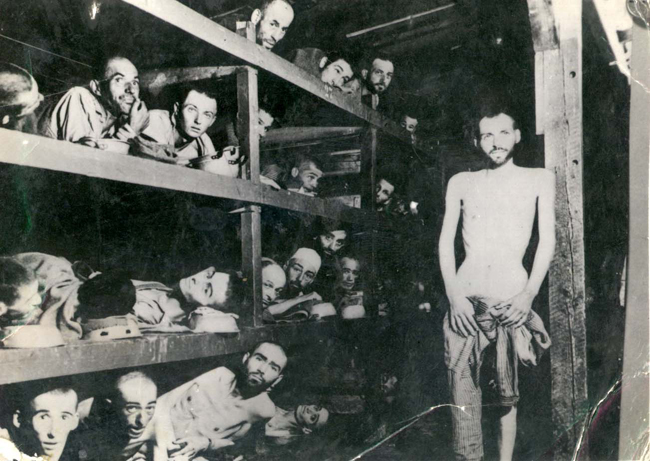 Second bunk:
Second bunk:
First from right– Elie Wiesel
Fourth from right:
• Herman Leefsma or
• Abraham Hipler or
• Berek Rosencajg or
• Zoltan Gergely
Fifth from right:
• Lajos Vartenberg (Yehuda Doron) or
• Yaakov Marton
Bottom bunk:
First from right – Max Hamburger
Third from right – Issac Reich
Fourth from right:
• Michael Miklos Nikolas Gruener or
• Gershon Blonder or
• Yosef Reich
Standing on the right: Chaim David Halberstam
Also notice that on the Flicker page the third man from left in the 2nd row up is not identified. That page went up in 2008. But on the Yad Vashem non-linkable “Anonymous No Longer” page for this particular photograph, this man is given two possible identities: Lajos Vartenburg (Yehuda Doron) or Yaakov Marton. On another Yad Vashem page with this picture, it reads:
On the second bunk from the bottom, third from left is Losh Wertenberg who later changed his name to Yehuda Doron, and according to other identification this man is Jeno Marton (identified by Yaakov Marton).
Screwy. Yad Vashem accepts whatever is sent to them because the memorial is by, for and about the Jewish people and they can do no wrong. However, we, of more discriminating nature, have to doubt that any of these names are correct … except Grüner.
Does Max Hamburger have a valid claim to be “the zombie” in the photograph?
It’s important to remember that this photo is recorded as having been taken on April 16, five days after the actual liberation. If this 4th person in the lower bunk had TB, would he still be lying in this barracks 5 days later or would he be in a hospital? If this were a hospital barracks, why do some of the men look so healthy? Elie Wiesel did not have TB, but, according to his own accounts, two days after liberation he ended up unconscious in the SS hospital with severe food poisoning. So Wiesel couldn’t be in this picture by his own statements!
Nicholas Grüner also had tuberculosis (TB) when this photo was taken. However, Grüner seems to think it was on the day of liberation, April 11, because he writes in his book Stolen Identity that as they were being marched to the camp entrance on that day (believing they were being taken somewhere to be killed), he managed to leave the line and run into the nearest barracks and jump into an empty bunk — which was this one. Later an American soldier came in and took a picture. Grüner was only 16 and had been living in the special children’s barracks, the same that Elie Wiesel says he was in. Grüner says his TB was not diagnosed until he was fully processed and he was then sent to a sanatorium in Switzerland, where he recovered.
I do not know if Max Hamburger has told a story about how his TB was treated. My information on him comes only from these few sources, mostly in the Dutch language. (Anyone who is able to translate the pdf article, please contact me.)
If Max Hamburger is the fourth man on the bottom row, he must also be the third man in the next row up (2nd row) because they are the same man. Yet he doesn’t say that — so something is very wrong with his claim.
Facial comparison of the two men
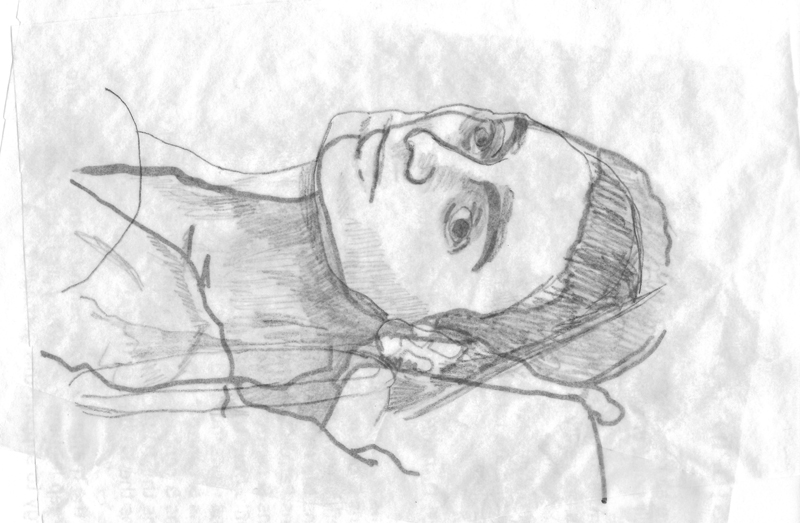
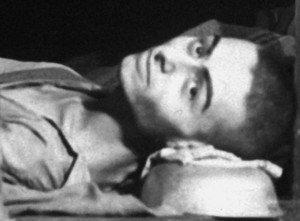
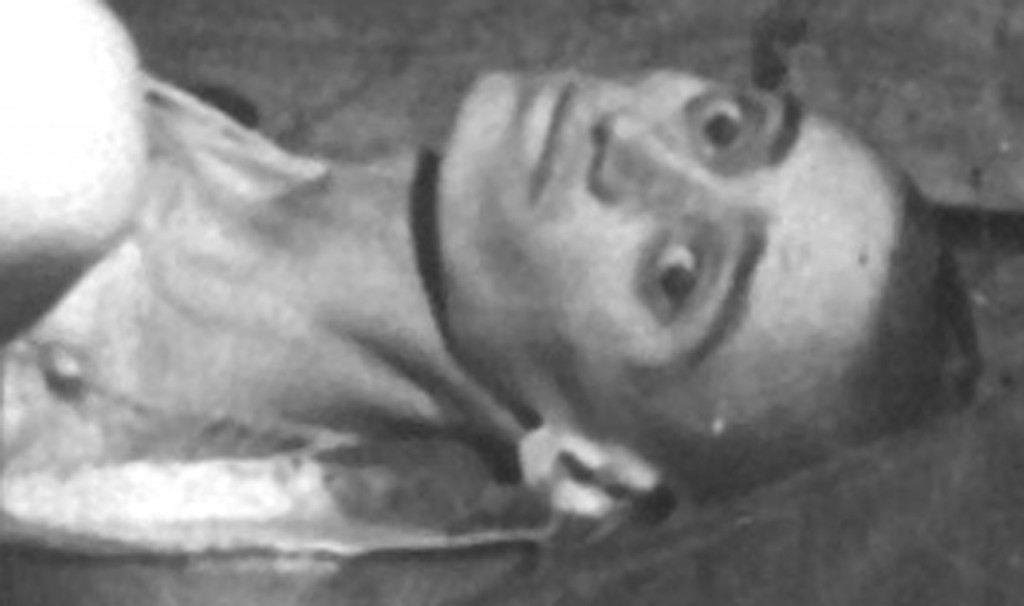
After printing the largest images of the two men’s faces, I did a careful tracing of each one. I then overlaid one on the other (in the drawing above) and determined:
- The nose, eyes and eyebrows, and head lined up perfectly one with another. This would not be possible if the two faces were not the same person.
- The mouth, while also remaining identical, is shifted upward on the “zombie” (as you look at the photo) and the entire lower face is widened and the jaw squared off. I’m not sure how this was accomplished, but on this particular figure it seems to be retouching paint. Look at that cauliflower ear, for example! The head is re-situated as laying flat on the bunk board (from the original pose of being propped up a few inches), necessitating a change in the relationship to the neck.
I thickened the outline of the “original” so it’s easy to tell which is which. You can compare the small photographic images of the two faces (left: 2nd row; right: bottom row) with the overlay to see how the very poor “retouching” job was done. Talk about sloppy work!
Why not just use a different person?
Why would they decide to insert the same man and then have to go to such lengths to make him look different? I think the answer to that is: several shots of this scene (with fewer live bodies than are there now) were taken on April 16, and only later it was decided to “fill in” the empty bunks by inserting figures from other negatives. For example, the two heads on the far left in the second and third row are clearly the same man with a slightly different twist of his head. The sleeping man, second from left in the second row, may be another view of the two men on the far left! Because why isn’t he facing the camera like all the others? The standing man is also a later addition inserted onto the photograph (see here).
As I pointed out before, this “Zombie copy” was also not gauged correctly size-wise — he is noticeably smaller than the men in the bunk right above his, when they should match up according to the laws of perspective.
More on Max Hamburger
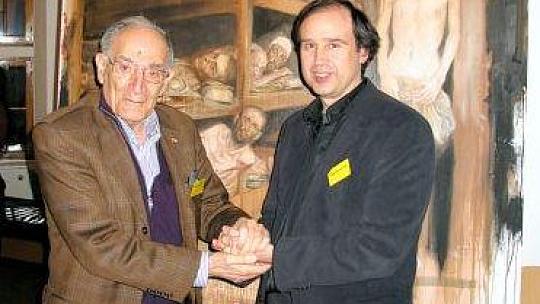 He is the son of a Dutch diamond polisher and baseball player, Hartog Hamburger. During a competition game in 1924, Hartog was hit on the head by a line drive when in the field. He died the next day as a result of the impact.
He is the son of a Dutch diamond polisher and baseball player, Hartog Hamburger. During a competition game in 1924, Hartog was hit on the head by a line drive when in the field. He died the next day as a result of the impact.
In February 2010, Max participated in the panel discussion of the Aachen Rabbi Mordechai drill in the German city of Aachen, along with the artist Máro and several others.
Both Máro (right) and his painting are shown in photo above, with Hamburger (left). According to the German news account:
“The discussion was all about the [then] 90-year-old Holocaust survivor Max Hamburger, whose speeches have gained great respect and […] the painting shown in the Castle Gallery by Máro, the image of a scene from the Buchenwald concentration camp.
“The artist explained the reasons which led him to the theme of the sufferings of Auschwitz. The series of pictures, which deals with the darkest chapter of German history, are meant to generate compassion and sensitivity for the suffering of the people depicted. […] Besides the issue of the Holocaust was also the art world itself, and the responsibility of the artist to contribute to the discussion of the Nazi terror, [which was] the focus of the [panel] discussion.”
4 Comments
Category Featured | Tags: Tags: artist Máro, Auschwitz, Buchenwald liberation photo, Elie Wiesel, Max Hamburger, Nicholas Gruner, Yad Vashem Memorial Museum, Yehuda Doron,
Social Networks: Facebook, Twitter, Google Bookmarks, del.icio.us, StumbleUpon, Digg, Reddit, Posterous.
Friday, December 28th, 2012
By Carolyn Yeager
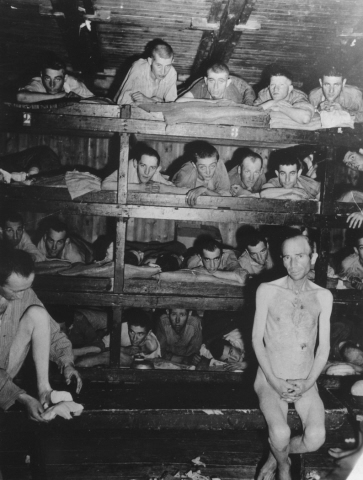 Here we see a very bizarre scene of clothed men being photographed lying in bunks, while a naked man sits on a bench in front of them. They are not looking at him and he seems unaware of them. And why not? This is clearly a composite photograph made up of two unrelated scenes.
Here we see a very bizarre scene of clothed men being photographed lying in bunks, while a naked man sits on a bench in front of them. They are not looking at him and he seems unaware of them. And why not? This is clearly a composite photograph made up of two unrelated scenes.
The United States Holocaust Memorial Museum (USHMM) titles this photo #78713 “Survivors lie on wooden bunks that are four tiers high in a barracks in the Buchenwald concentration camp.”
No mention of the naked man. This is truly fitting of the expression “the elephant in the living room” wherein everyone pretends not to notice something they can’t or don’t want to try to explain.
The description by the USHMM goes on to say:
The original caption reads, “This photo shows the conditions and the amount of sleeping space for the prisoners at Buchenwald concentration camp. They range from young kids to old men, all doing the same amount of work each day.”
According to the Signal Corps caption, the photo was taken on April 23, 1945.
Yet the official date given for this photo on the USHMM Online Archive page is: Wednesday, April 11, 1945 – Monday, April 23, 1945; the photographer Donald R. Ornitz; courtesy of Mary Dickinson.
April 11 was “Liberation Day” and they always want to give the impression that all the pictures were taken on that day — that everything seen is unrehearsed and just as the liberating army found it. Yet this photo was “set up” 12 days after liberation. Another point: Where are the “old men,” and where are the “young kids” in this photo? They all look to be in their late teens and 20’s up to their 30’s at the most. No old men, no young kids. What were these ex-‘prisoners’ doing during those 12 days; where were they living? How were they being treated? Well, they were being asked to participate in the creation of the post-war propaganda ordered by Eisenhower, and that is what they did. Were they paid? What were they promised? Did they just hang around in the barracks as usual?
The naked man and his strange shadow
The men in the bunks are not sick or emaciated – they appear healthy and alert – so the military intelligence division responsible for creating photographic propaganda decided to add a sick man to the photo in order to support the message they were charged to send to the world of sub-human conditions at Buchenwald. It’s not hard to see how they did it — the two men on the bench were super-imposed on the other picture. The top edge of the bench is lined up with the bottom slat of the bunk, giving the impression that the bench is some feet away from the bunk. [I’ve copied the photo again for ease of seeing it while reading.]
 So far so good. But once again, the shadows present a problem. Notice that there is a dark shadow behind every man in the bunk cast on the wall behind him, due to the bright flash of the camera and maybe even a spotlight shining on them. The naked man also has a similar black shadow around his head and along his right side although there is only empty space behind him. There is no wall, so what is the shadow being made on? Notice there is no shadow created by his legs. This shadow seems to me to be totally impossible. We don’t see a shadow made “in the air” behind the standing naked man in the Famous Buchenwald Lie-beration photo discussed in the previous posts. But here we do.
So far so good. But once again, the shadows present a problem. Notice that there is a dark shadow behind every man in the bunk cast on the wall behind him, due to the bright flash of the camera and maybe even a spotlight shining on them. The naked man also has a similar black shadow around his head and along his right side although there is only empty space behind him. There is no wall, so what is the shadow being made on? Notice there is no shadow created by his legs. This shadow seems to me to be totally impossible. We don’t see a shadow made “in the air” behind the standing naked man in the Famous Buchenwald Lie-beration photo discussed in the previous posts. But here we do.
One can only explain these two men’s presence in the picture by assuming they were photographed in a hospital or clinic setting where they were being examined or treated; perhaps the man on the right was asked to be photographed nude to make a record of a “mistreated, starved victim of the Nazis,” while he was in reality a victim of disease. His demeanor is one of both defenselessness and humiliation, just perfect as propaganda.
Update! January 7, 2013
Another consideration, brought to mind by Tom’s critical comment, is that the naked man appears to be photographed from slightly above, because we are looking down on his legs and he has no visible neck. But we’re viewing the men in the bunk from a lower position, with the camera flash lighting up the two upper rows. Studying it enlarged 400% on Internet Explorer, there definitely appear to be two camera angles. In addition, the shadow made by his left foot is not convincing; why isn’t it flat on the floor? The black area to the right of his right foot is the leg of the bench.
Might as well repeat here, as I wrote in my reply to Tom in the “Comments”: The shoulders and upper arms of this seated man (and his ear!) are very white, while the rest of his body including his face have a light greyed tone. The difference runs from his neck to his armpit, exactly the same on both sides. It cannot be possible that he wore clothing outdoors that only covered his shoulders and upper arms, leaving the rest exposed! No, the most likely answer is that the arm and shoulder areas have been painted in … for whatever reason. Plus, where is this man’s navel? He doesn’t have one.
The other seated man on the bench looks larger in size, especially noticeable is the head and the hands. I see some signs of retouching on him — the dark line behind his raised knee and the wrinkle lines on the sleeve covering his left arm. Neither look natural.
A mislabeled photo – turning Germans into Jews
The picture of four men, below right, is in the Museum’s Buchenwald photo archives labeled as “Group Portrait of Four Jewish Youth at liberation in Buchenwald,” photo #27289. It’s dated Wednesday, April 11, 1945 (Liberation Day!), courtesy of Morris Rosen; no photographer listed. It adds this information: “Nucher, (the donor’s friend) is pictured in the lower left. Pictured in the center is Jacob Rosenthal from Satu-Mare.”
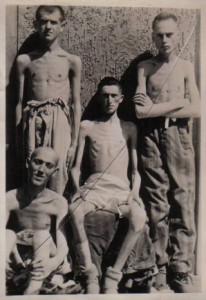 Consider the extent of the irresponsible misinformation on the USHMM website when you learn that these are German men after being interned at the notorious Bad Nenndorf secret prison set up in Germany by the British during their occupation of north-west Germany in 1945. I used this photo in the post for my Oct. 29 radio program The Heretics Hour. The treatment of the prisoners in this camp by the British was far worse than anything experienced by those at Buchenwald. Below are more pictures of documented Bad Nenndorf victims. All suffered from actual, unnecessary starvation.
Consider the extent of the irresponsible misinformation on the USHMM website when you learn that these are German men after being interned at the notorious Bad Nenndorf secret prison set up in Germany by the British during their occupation of north-west Germany in 1945. I used this photo in the post for my Oct. 29 radio program The Heretics Hour. The treatment of the prisoners in this camp by the British was far worse than anything experienced by those at Buchenwald. Below are more pictures of documented Bad Nenndorf victims. All suffered from actual, unnecessary starvation.
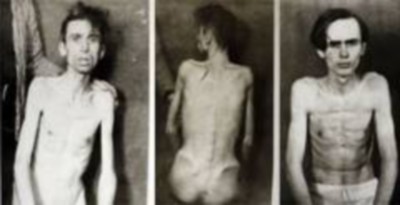
More needs to be done to expose all the photographic “evidence” in the USHMM archives that are forgeries or are mislabeled. There is obviously no vetting or double-checking of what is turned in by Jewish contributors; it’s accepted and catalogued “as is,” just like at Yad Vashem in Israel. We must realize that there is very little about the “Holocaust” that is not fraudulent, either by design or through negligence. The USHMM is a totally Zionist operation and thus is a propaganda mill, not an institution pursuing historic accuracy.
Tutorial on Cast Shadows
In case some readers have trouble understanding shadows and why the shadow “drawn” around the head and body of the seated man (or he was originally seated in front of a wall) are a give-away for forgery, I am presenting two images here that should explain it.
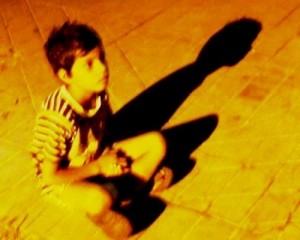 Notice that the shadow cast by this boy (right) sitting in open space is not around his body but on the ground. Shadows cannot be seen “in the air” but only on a surface.
Notice that the shadow cast by this boy (right) sitting in open space is not around his body but on the ground. Shadows cannot be seen “in the air” but only on a surface.
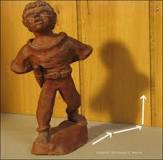
Likewise the statue at left is a short distance away from a wall. But notice that the shadow follows the floor before it reaches the wall, making the shadow on the wall quite a bit shorter than the object itself.
12 Comments
Category Featured | Tags: Tags: Bad Nenndorf, Buchenwald Lie-beration, bunks, composite photograph, forgery, USHMM,
Social Networks: Facebook, Twitter, Google Bookmarks, del.icio.us, StumbleUpon, Digg, Reddit, Posterous.
Sunday, December 23rd, 2012
By Carolyn Yeager
copyright 2012 carolyn yeager
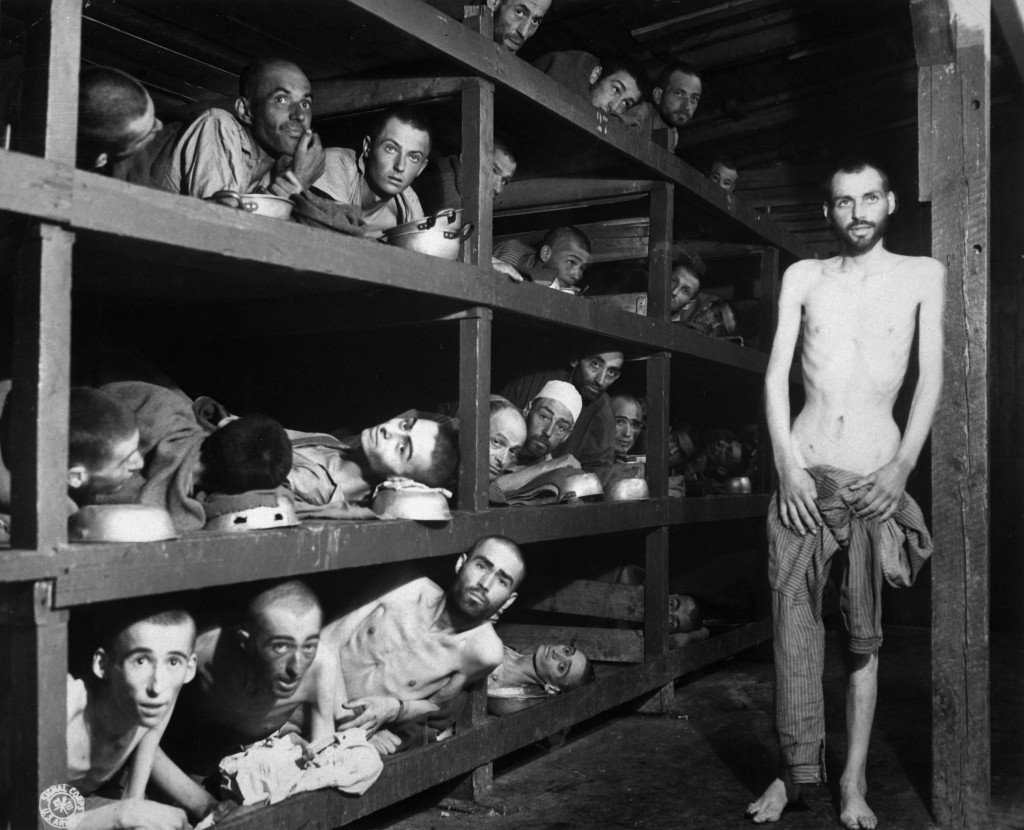
Do you remember the nursery rhyme that goes:
Sugar and Spice and all things nice, that’s what little girls are made of.
How about this one:
Magic and Trickery and all things fakery, that’s what “the holocaust” is made of.
This very famous image associated with the so-called “Holocaust” that was discussed in the previous post has turned out to be fraught with fakery. A sharp-eyed reader, Paul Borresen, noticed something that, once seen, makes one wonder how it was not seen before!
What he noticed is that, in addition to the forged standing man exposed in my previous post, one of the men in the bunks appears twice in this Famous Buchenwald Lie-beration Photo, and the similarity is unmistakeable.
Viewing the photo above, enlarged as much as it can be … find the young man lying on his back with head turned toward the photographer, in the 2nd row up from the bottom, 3rd from the left. His head is resting on his food bowl. (close-up on left, below, designated ‘Original’)
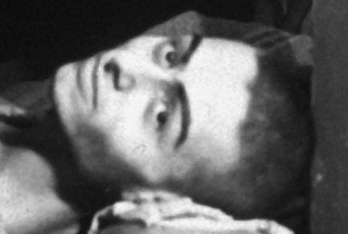
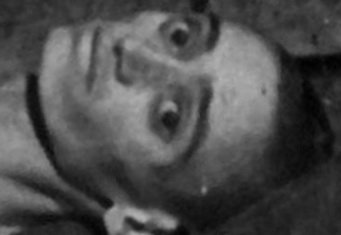
Now look at the young man in the same position in the bottom row, 4th from the left. He is the same man! (close-up on right, above, designated ‘Copy’) The food bowl has been removed from underneath his head, leaving it to a military intelligence photo-retoucher to redo his throat and neck, but in a very un-anatomical manner. Have you ever seen a neck that looked like that? I have not. In an attempt to retain a lesser portion of the ‘gown’ he was wearing so that it would not look the same as the ‘original,’ more bare skin is left showing, but without any anatomical correctness whatsoever.
The retoucher was not a trained artist and was in over his/her head with this assignment. For example, look at the ear. It consists of a few strokes of light-colored paint in an attempt to make something resembling an ear, but failing. Ears are one of the most difficult parts of the body to draw or paint in a convincing manner, but it was necessary to add an ear to this ‘copy’ because the ear is not showing on the original man in the bunk above; it is buried against the upside-down food bowl and some material that’s covering it. The botched ear of the ‘copy’ is one of the biggest giveaways of fakery in this photo, but not the only one.
What’s with all these thick, black eyebrows?
Let’s look at the eyes and eyebrows next. The man whom we are calling “the original,” has very dark, thick eyebrows but otherwise looks normal. The shadow under his chin is probably what was actually there – bringing attention to the fact that a very bright light source in a dark room was shining on the men, and hitting the lower two rows of bunks more than the upper two rows. His “copy” also has very dark, flat eyebrows but they have been redrawn to begin higher up from the bridge of the nose and extend down to the outside corner of the eye, giving him a wild look. Adding to this wild-eyed look is the delineation of more distinct eyelids, rounding the eyes and enlarging the irises, all of which create the zombie look which the ‘original’ doesn’t have.
A couple more things were done in a futile effort to camouflage this ‘copy’: the rounding of the forehead, head, and hairline, and the squaring of the chin and lower jaw. A crude line of black paint, applied all the way up to the big, white ‘cauliflower’ ear, was evidently thought to suffice for a shadow under chin and jaw. Look closely especially where it meets the ear and you can recognize it is paint.
Yet, the nose, mouth, upper jaw and facial shadows remain exactly the same in both figures. The result is a grotesque second person that I suppose has been eliciting sympathy from clueless viewers all these years.
This grotesque, over-worked ‘copy’ is also smaller than it should be for the bunk it occupies – actually being the same size as the man peering out from the next bunk further down. Maybe the forgers thought this would make him look like a young boy. If so, they failed to realize that boys don’t have tiny heads! Now, this peering man has clearly had his eyebrows and eyes emphasized with black paint or pencil. Or he may be totally fake. Others whose eyebrows were treated similarly are: The “elie wiesel” face has heavily emphasized eyebrows; also the second and third man in the third row, and all the men in the top row. I believe the best explanation for this phenomenon is this: the poorly painted eyebrows of the ‘copy’ would stand out too much from the natural-looking eyebrows of all the rest, so it was decided to give a swipe of black paint to many other eyebrows also, including our ‘original.’
As a practicing artist most of my life, from childhood on, who has drawn and painted hundreds of faces and done many portraits, I know quite well how to touch up faces and how tiny adjustments can make a big difference in attaining a likeness. The assignment here was to do the opposite of attaining a likeness; it was to take a photographic carbon copy and make it look unlike the original. If I had done the work on this photograph it would be far superior to the image we have, which is a really sloppy job by people who are not artists and therefore don’t have “an eye” for how things actually look and/or don’t know how to make it look that way. Which is a good thing for us!
NEW ENLARGED IMAGES! In these close-ups showing more of the neck and the space around the faces. we can see more clearly how the head of the “copy” in the lower bunk is angled back, just slightly, since he is lying with his head directly on the floor of the bunk, not propped up as is the “original.” I think it’s likely that after altering the face and hair, and adding an “ear,” the forgers severed the face/head at the jawline and proceeded to paint a brand new neck that would fit the newly angled face with the slightly raised chin. This is why everything below the chin is so horribly wrong. We can see a collar bone and shoulder in the ‘original,’ but there is no bone structure at all in the ‘copy.’ The crude black line representing a shadow under the chin serves to “attach” the two parts together.
The ‘copy’ also has far less contrast, is overall grayish, which would happen from all the retouching, or also that this copy was set for low contrast. We can see that the shadows on the side of the face follow the same pattern even though they’ve been interrupted here and there. We can also see clearly how the upper line of the face was indented right below the cheekbone, and was added to along the mouth area. The line of the mouth between the upper and lower lips goes all the way to the edge of the face, but on the ‘copy’ it stops short of the edge. You can see the gray paint added at that upper corner of the mouth.
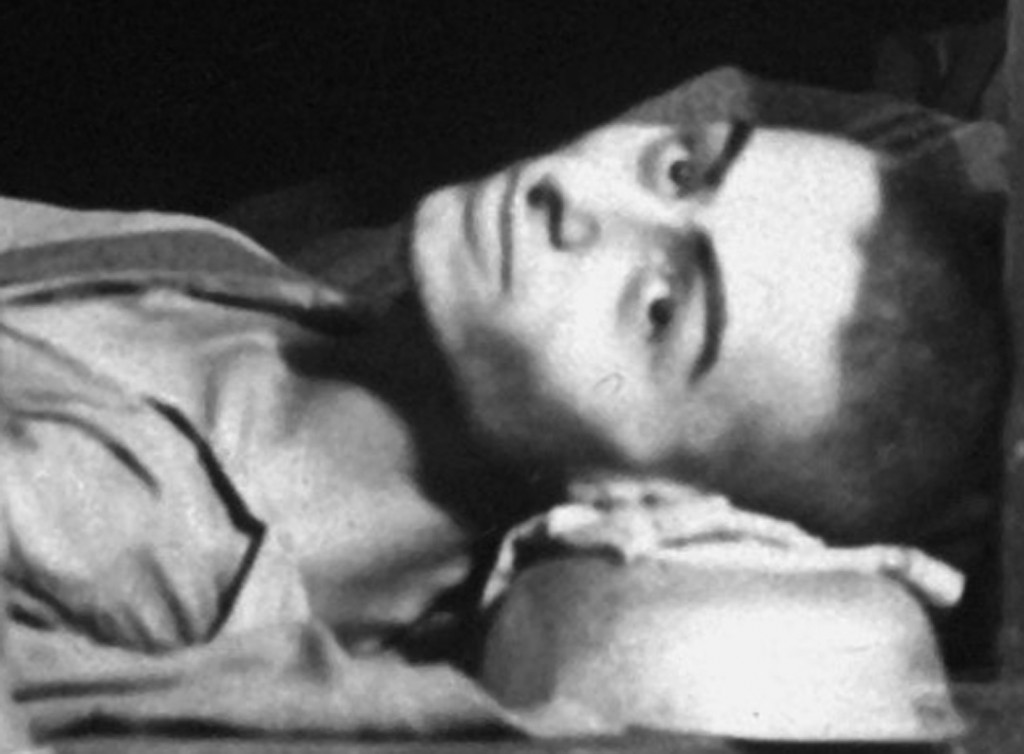

Hundreds of forged and mislabeled photographs make up the “Holocaust”
This is one photograph out of many that were also forged. I believe it is one of the most important because it has been given such a prominent place among the documents “proving” the “Holocaust.” Elie Wiesel, or his handlers, no doubt selected this photo – from many possible others wherein he could be falsely identified as one of the crowd – because it was already so well-known and was in many books and publications. Therefore, whenever it is published somewhere, it can be said that Nobel Prize winner Elie Wiesel is in the picture. However, they didn’t count on it being exposed as a fraud – they never do. But now it has been, and it’s up to us – all of you reading this – to see that the exposé becomes known everywhere this photograph appears. This is what it will take to break the spell.
What we have to fight against – our own people
A fellow revisionist who helps me with technical issues from time to time for this blog actually wanted me to hold back on this because he could not be sure that the two figures discussed in this article are the same man! What would it take to convince him? A confession from the perpetrators? A corroboration from an authority figure or a Jew? Why the difficulty in contradicting the given narrative?
A poster at Stormfront who boldly calls himself “The Hammer of God” had this to say when confronted with the empty black area in the NYTimes reprint:
Idk, newspapers did have pretty low-quality pictures at that time, so maybe that whole area was just set to black, but it looks bright enough for that person to have shown up. The lighting actually seems a bit brighter on that man, which makes it even stranger why that section would appear black. So, perhaps it is a forgery, but I can’t say for certain.
People like ‘The Hammer” should spend more time studying how the magic spell works. It works like this: Evidence doesn’t count; don’t trust it; don’t trust your own brain; trust the consensus. Far too many of us cannot break out of the consensus about the “Holocaust” and the ” evil Nazis.” For this reason, we need to clearly understand what is being done, and how it’s being done. The “how” is very important. It’s a kind of sleight of hand, a magic act, and we are the ones being both entertained and kept in servitude by it. Understanding this is how we will break the spell.
7 Comments
Category Featured | Tags: Tags: Elie Wiesel, fakery, famous Buchenwald photo, Holocaust, magic, photo retouching, trickery,
Social Networks: Facebook, Twitter, Google Bookmarks, del.icio.us, StumbleUpon, Digg, Reddit, Posterous.
Wednesday, December 19th, 2012
By Carolyn Yeager
copyright 2012 carolyn yeager

This is the photograph that Allied Supreme Commander General Dwight David Eisenhower ordered, in April 1945, to be posted in every German town and city 1 to show the defeated population the “true meaning of Nazism.”
Was this photo made to order according to Ike’s specifications?
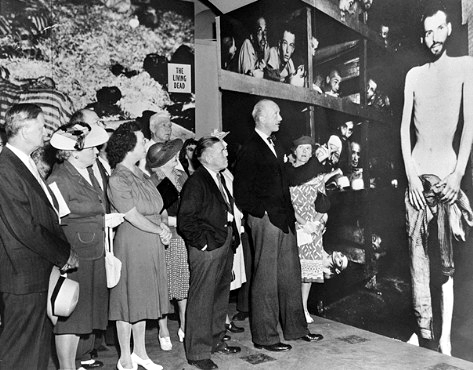 A huge blown-up version then went on tour in the United States for the same purpose, to impress on the American people what evil they had gone to war against; why the sacrifice of blood and treasure was justified! Left: “A traveling exhibit of larger than life size photographs was first shown in St. Louis, MO in summer 1945 and then taken to Washington, DC.
A huge blown-up version then went on tour in the United States for the same purpose, to impress on the American people what evil they had gone to war against; why the sacrifice of blood and treasure was justified! Left: “A traveling exhibit of larger than life size photographs was first shown in St. Louis, MO in summer 1945 and then taken to Washington, DC.
It was plastered on the front pages of newspapers across the country. Thus it became one of the most iconic images representing WWII and of what later came to be known as “The Holocaust.” The intention was to portray the war as a noble effort to “save the Jews from enslavement and extermination,” just as the equally bloody American Civil War had come to be taught as a war “to free the slaves,” i.e. the Negroes who were not citizens of the country they were living in.
Both are black propaganda campaigns that still use whatever is at hand, whether it be subterfuge or not.
In the case of the above photograph, we have learned that the standing figure, the part that makes the biggest, most memorable impact on the viewer, was added later – it was not in the original photo allegedly taken by Private H. Miller of the Civil Affairs Branch of the U.S. Army Signal Corps on April 16, 1945, five days after the “liberation” of the Buchenwald Concentration Camp by American forces.
A blogger, the owner of the Winston Smith Ministry of Truth website who goes by the nickname Black Rabbit, decided a week or so ago, out of curiosity, to order the New York Times newspaper article from May 6, 1945 in which this photo was published, and when it came the photo looked like this:
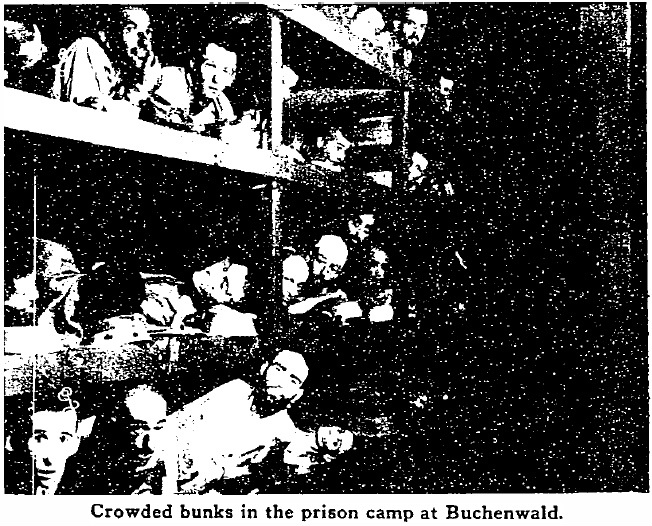
Here is page 2 and 3 of the New York Times article (click to show entire page):
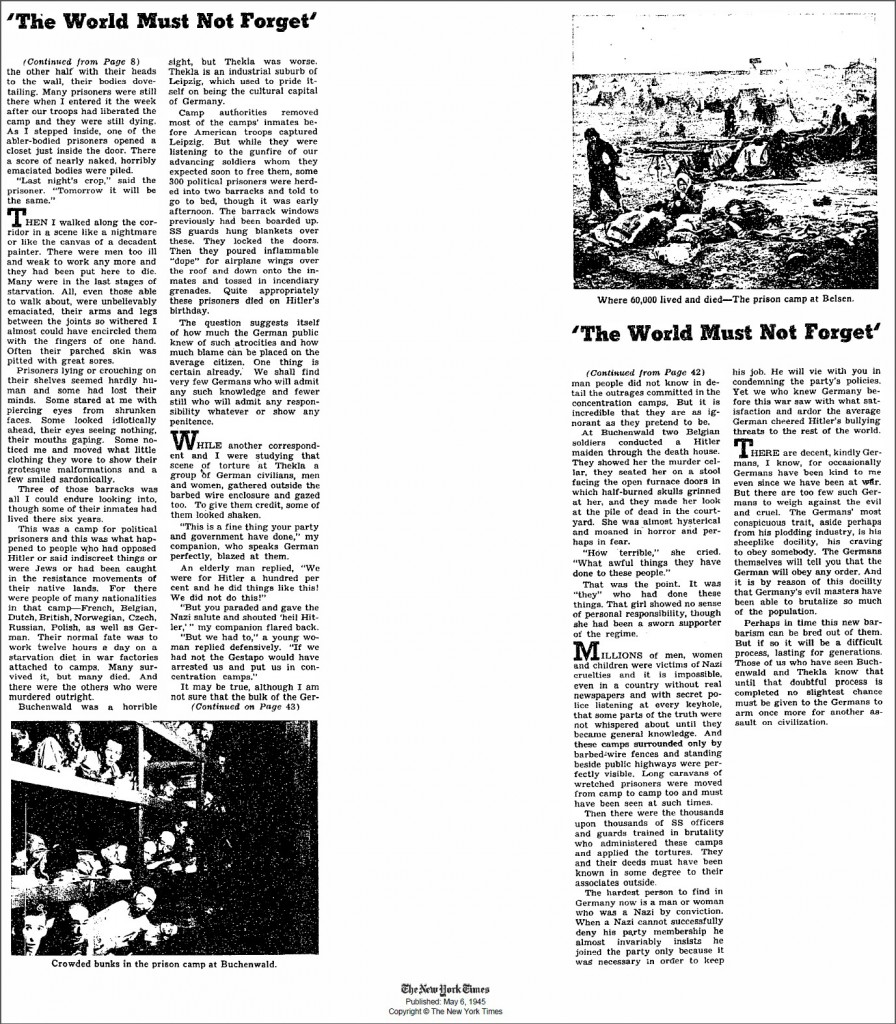
What a shock to see only an empty dark space, and in the New York Times no less!
What happened to the standing man? I was the first to bring it to the attention of the participants in the comment section of furtherglory’s Scrapbookpages Blog after Black Rabbit posted a link to the original article there, and then we quickly began noticing the tell-tale signs of FORGERY about this strange figure who had always appeared odd to me standing there naked as he is, but did not arouse enough suspicion amidst all of the onslaught of “holocaust” imagery, stories and news articles with which we are constantly being bombarded. We see what we are supposed to see, what we’re told we’re seeing, and almost always leave it at that. It is also one of the better photo-forgery jobs of Allied holocaust black propaganda – could that be because it was being done at the behest of the Supreme Commander himself?
But let me point out some problems with this figure:
- His position in relation to the post is an impossible one (see top photo; click once on image and then again for full enlargement). He is not leaning against the post, but neither is he standing in front of the post. His feet are in line with the base of the post, but his left shoulder and arm are in front of the post – without any shadow of any kind. There is something ghostly about this figure, as though he’s an apparition.
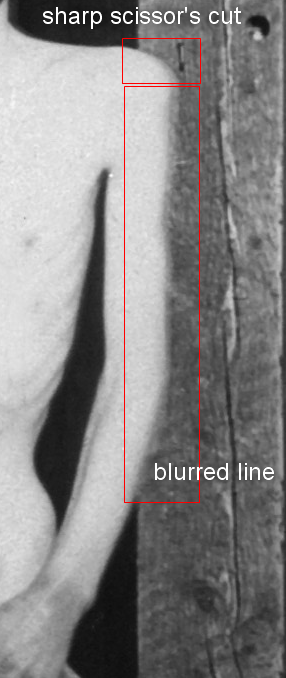 The edge of his left arm is fuzzy, as if it is drawn or painted where it meets the post (detail right). The rest of the outline of his shoulders and arms is very sharp, as though cut with scissors. [In most large-scale reproductions of this photo we have seen (as shown on the Winston Smith Blog), the left edge of the arm is cropped because the larger the image the more noticeable it is.
The edge of his left arm is fuzzy, as if it is drawn or painted where it meets the post (detail right). The rest of the outline of his shoulders and arms is very sharp, as though cut with scissors. [In most large-scale reproductions of this photo we have seen (as shown on the Winston Smith Blog), the left edge of the arm is cropped because the larger the image the more noticeable it is.- Notice the blinding whiteness of his torso, and how different it is from his face, hands and legs which are darker (top photo again). The more one studies the torso and arms, the more they look like a drawing rather than a photograph. Notice how faint are the nipples and definition on his chest compared to the man in the lower bunk who is pushing himself forward the better to be seen.
- Notice the relaxed, almost dreamy expression on the face of the standing man (detail below): his lips are parted in a smile; his eyes are looking off into the distance, not at the photographer. He appears in an untroubled state of mind, unsuited to the environment he’s in and unlike the other men .

- 5. A light source seems to be coming from above right as we face the photo, but the shadows on the legs and feet suggest a light source directly from above. Also, the angle of the shadows on the floor made by the post and by the right leg of the standing figure are not aligned.
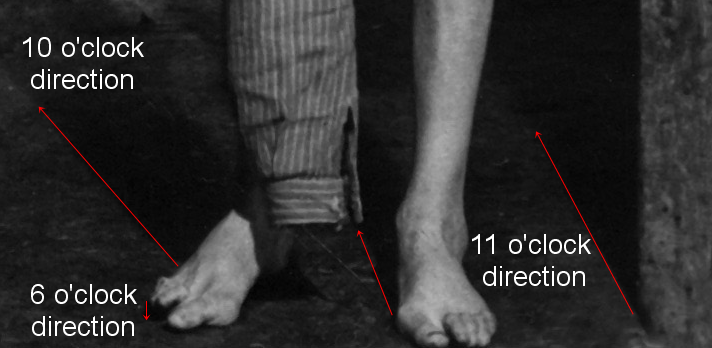
6. Ask yourself why he would be standing there completely nude, with that unlikely expression on his face, five days after the liberation? Also ask yourself why these men would still be lying in these bunks fully dressed, though some having taken their shirts off for effect, five days after the liberation? The only answer is that it’s a staged, arranged photo-shoot for propaganda purposes, not an impromptu entry by a photographer right at the time of liberation – as we are led to believe (because we are supposed to believe it) by the captions that accompany the photo. For example, in the Moberly (Missouri) Monitor-Index on April 30, 1945, the caption to this photo reads: “Slave laborers in their crowded rough bunks in the Buchenwald concentration camp near Jena, Germany, as they were found when U.S. troops of the 80th Division entered the camp.”
Fakery such as this is common in war propaganda; it just usually doesn’t last so long
We not only have the NYT newspaper article showing the photograph without the standing man, but we can also point out tell-tale signs that this figure was added to the photo … and that it was itself doctored to show a very skinny torso of a “starving” man. What deceit! If Eisenhower propaganda specialists had really found such scenes, they would not have had to invent them!
And yes, I’m asking how many personnel were aware, had to be aware, of this type of forgery. And some still living who are still perfectly aware that “The Holocaust” was and is a post-war intelligence operation with no holds barred. For example, so many of the photos that are archived and sold to the gullible public by the propaganda mill that goes by the name of the United States Holocaust Memorial Museum (USHMM) (using your tax dollars) are wildly mislabeled. The USHMM identifies this very photograph as follows:
Former prisoners of the “little camp” in Buchenwald stare out from the wooden bunks in which they slept three to a “bed.” [Photograph #74607]
Elie Wiesel is pictured in the second row of bunks, seventh from the left, next to the vertical beam.
The man in the bottom left hand corner has been identified as Michael Nikolas Gruner, originally from Hungary, Gershon Blonder Kleinman or Yosef Reich. Isaac Reich is in the bottom row, second from the right and Max Hamburger is on the bottom row, fourth from the left. Perry Shulman from Klimitov, Poland is on the top bunk, second from the left (looking up). The man in the second row, third from left has been identified as Dawid Najman. The man in the second row, fourth from the left has been identified as Abraham Hipler; Berek Rosencajg from Lodz or Zoltan Gergely from Cluj. The man on the third bunk from the bottom, third from the left, has been identified as Ignacz (Isaac) Berkovicz, Abraham Baruch and Paul Argiewicz . Juraj (now Naftali) Furst is pictured in the third bunk, fifth from the left. Standing on the right is Chaim David Halberstam.
Others say the standing man is Simon Toncman, who after the ‘Liberation’ returned to his home country The Netherlands, started a family and became a successful businessman. He refused to talk about this photo until the day he died. 2 (Why would that be? Because he knew it was a fake! And because he had been told to keep quiet about it. That’s the best, and only reasonable explanation.)
Of the identified men, one is definitely mis-identified! — and that is Paul Argiewicz. The real Paul Argiewicz was discovered by furtherglory; I picked up his work here (scrowl down to the German drivers license). How could the “Jewish Organizations” with access to Bad Arolson get that so wrong? They all do it all the time. For example, the ‘meantime -Allen Hall” article says that “Red Cross records show Heiman Leefsma survived Barrack 56 as a 20-year-old.” Yet when we see who he is identified as in the Flicker picture, he has a balding head and looks like the oldest man there.
And then there is Elie Wiesel! Please see especially here for proof that the man in the bunk is NOT Elie Wiesel. So that is more fakery surrounding this photo, but in this case the person was really in the original photograph, but is an unknown person. The decision to call that man Elie Wiesel was only made around 1983, with a Nobel Prize in mind.
Both the USHMM and the Allan Hall article are full of errors. There is no need for holocaust “historians,” filmmakers, or “researchers” to be concerned about accuracy — it doesn’t matter how iconic or world-famous they are. Sloppiness goes unpunished, especially since so much of it is on purpose — to deceive and keep the myth going. I will be posting about some other fraudulent pictures from Buchenwald in the future.
End Notes:
1. “US army commander General Dwight Eisenhower ordered this picture to be posted in every German town and city to show the defeated population the true meaning of Nazism,” writes Allan Hall. http://www.meantime.com.au/mean-time-articles/2008/8/12/60-years-on-the-faces-of-nazi-shame-get-their-names-back/
2. Same source (meantime.com): Quote – “Now, 63 years after they were liberated, they have been united again in print by a German newspaper granted rare access to the files of the Red Cross Tracing Service at Bad Arolsen, Germany.
Using the original German SS registration cards and the camp’s “Todesbuch” – book of death – researchers were able to match up names with Jewish organisations around the globe.
Paul Argiewicz, 82, is now living in the US. He lost his parents in the gas chambers and is a regular on American TV shows talking about his experiences.
Red Cross records show Heiman Leefsma survived Barrack 56 as a 20-year-old. A Dutch national, he vanished shortly after liberation and inmate 130305 has not been heard from since.
Nikolas Gruener, now 80, is a Hungarian Jew who was suffering from TB at the time of liberation. “We warmed ourselves on the bodies of the dead before they cooled down,” he said. A successful businessman after the war, he took part in a number of interviews recently for director Steven Spielberg’s Holocaust archive. He lost his parents and two brothers in the camps.
Max Hamburger is now 88. He was active in the resistance in Amsterdam. He survived the death factory of Auschwitz because he was employed as a medic and went on to Buchenwald, where he weighed just 19 kilograms at liberation. After the war he settled in Belgium,where he became a psychiatrist. He speaks regularly to universities about the Holocaust and his experiences.
Nobel Prize winner Elie Wiesel is one of the most well-known Holocaust survivors. Wiesel, who coined the phrase “never again”, is now 79. He was awarded the peace prize in 1986. “That is me,” he said, when shown the photo in the 1960s.
Simon Toncman, a Dutch Jew, was 28 at the time of liberation. He married a survivor from Auschwitz and went on to have a successful career in accountancy in his homeland before dying from a genetic bowel complaint in 1975. He never spoke about his Holocaust experiences but revelled in his “wonderful family life”. He had nine grandchildren before his death.
Mel Mermelstein, 81, is a Hungarian Jew whose whole family perished in Auschwitz. He was portrayed by Leonard Nimoy in a 1991 movie called Never Forget, about his lawsuit against Holocaust deniers in America who suggested the gas chambers were a myth. His autobiography is called By Bread Alone and he too speaks regularly about his time in the camps. Of the photo, he said: “We were alumni of some of the most terrible places on earth. This picture and the men in it mean more to me than I can say.”
26 Comments
Category Featured | Tags: Tags: Elie Wiesel, famous Buchenwald photo, forgery, General Dwight Eisenhower, New York Times, Paul Argiewicz, photo-fakery, Scrapbookpages Blog, Simon Toncman, USHMM, war propaganda, Winston Smith Ministry of Truth,
Social Networks: Facebook, Twitter, Google Bookmarks, del.icio.us, StumbleUpon, Digg, Reddit, Posterous.
Sunday, December 16th, 2012
To anyone who has sent an email to [email protected] in the past month or so:
I am sorry that it was not received because that email account has not been available to me for some time. I believe it was cancelled during the many changes CODOH has been undergoing recently and whatever it contained has been lost. If you want to get some information to me, just write it in a comment on the blog; I can reply to you from that without posting the comment.
Elie Wiesel Cons The World is moving and will no longer be under the sponsorship of CODOH, but it will continue as before under my direction and you will not notice any difference. I will let you know when the move is complete and there is an email account again. I could really use some contributions to help with the move and to pay the hosting costs in the future.
Many thanks to Bradley Smith for his generous support for this site since it’s beginning in 2010. He is definitely one of the good guys. Let’s all move on into a year of great accomplishment in 2013. Some exciting new breakthroughs are coming! (As soon as I get the time to write about them here.)
 Does Mermelstein give many dates in his book? According to this source, he arrived at Buchenwald on or about February 10, 1945, he remained in the camp until it was liberated by American troops on April 11, 1945. That is only a 2-month stay. He was born on Sept. 25, 1926, making him exactly 2-years older than Elie Wiesel. He is now around 85. (recent photo of Mermelstein at left)
Does Mermelstein give many dates in his book? According to this source, he arrived at Buchenwald on or about February 10, 1945, he remained in the camp until it was liberated by American troops on April 11, 1945. That is only a 2-month stay. He was born on Sept. 25, 1926, making him exactly 2-years older than Elie Wiesel. He is now around 85. (recent photo of Mermelstein at left)


































